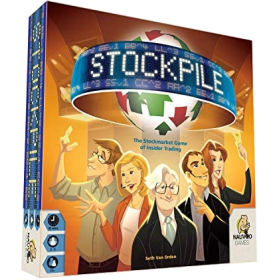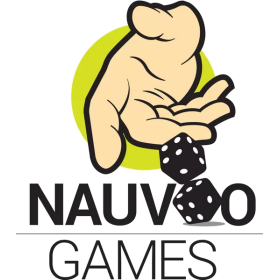Stockpile
 Stockpile ist ein Wirtschafts-Brettspiel, das die traditionelle Lagerhaltungsstrategie „Niedrig kaufen, teuer verkaufen“ mit mehreren zusätzlichen Mechanismen kombiniert, um ein rasantes, fesselndes und interaktives Erlebnis zu schaffen.
Stockpile ist ein Wirtschafts-Brettspiel, das die traditionelle Lagerhaltungsstrategie „Niedrig kaufen, teuer verkaufen“ mit mehreren zusätzlichen Mechanismen kombiniert, um ein rasantes, fesselndes und interaktives Erlebnis zu schaffen.
Bei Stockpile agieren die Spieler am Ende des 20. Jahrhunderts als Börseninvestoren in der Hoffnung, reich zu werden, und der Investor mit dem meisten Geld am Ende des Spiels ist der Gewinner. Stockpile basiert auf der Idee, dass niemand alles über die Börse weiß, aber jeder etwas weiß. Im Spiel manifestiert sich diese Philosophie auf zwei Arten: Insiderinformationen und der Aktienstapel.
Zunächst erhalten die Spieler in jeder Runde Insider-Informationen. Diese Informationen bestimmen, wie sich der Wert einer Aktie am Ende der Runde ändern wird. Indem er privat lernt, ob eine Aktie steigen oder fallen wird, hat jeder Spieler die Chance, dem Markt voraus zu sein, indem er zum richtigen Zeitpunkt kauft oder verkauft.
Zweitens kaufen die Spieler ihre Aktien, indem sie auf Stapel von Karten bieten, die als Aktienstapel bezeichnet werden. Diese Stapel enthalten eine Mischung aus offenen und verdeckten Karten, die von anderen Spielern im Spiel platziert wurden. Auf diese Weise kennt niemand alle Karten in den Aktienstapeln. Auch sind nicht alle Karten gut. Handelsgebühren können die Stapel vergiften, indem sie die Spieler dazu bringen, mehr zu zahlen, als sie bieten. Indem Aktien und andere Karten versteigert werden, katalysiert Stockpile die Interaktion der Spieler, insbesondere wenn potenzielle Gewinne aus Insiderinformationen auf dem Spiel stehen.
Beide Mechanismen werden mit einigen Börsenelementen kombiniert, damit die Spieler beim Verkauf einer Aktie mehrere Faktoren berücksichtigen können. Hältst du an einer Aktie fest, in der Hoffnung, einen lukrativen Aktiensplit zu ergattern, oder verkaufst du sie jetzt, um einer möglichen Insolvenz des Unternehmens zu entgehen? Kannst du deine Aktien bis zum Ende des Spiels behalten, um Mehrheitsaktionär zu werden, oder benötigst du jetzt die Liquidität in bar für zukünftige Gebote? Riskierst du alles, indem du stark in ein Unternehmen investierst oder minderst dein Risiko, indem du dein Portfolio diversifizierst?
Am Ende weiß jeder etwas über die Börse, also kommt es auf die Umsetzung der Strategie an. Wirst du in der Lage sein, die Bewegungen des Aktienmarktes mit Sicherheit zu navigieren? Oder werden deine Investitionen aufgrund schlechter Prognosen untergehen?
Spielerzahl: 2 - 5
Spieldauer: 39 mn
Komplexität: 2 / 5
Spiele Stockpile und 1184 andere Spiele online.
Kein Download notwendig, spiele direkt im Webbrowser.
Mit deinen Freunden und tausenden Spielern aus der ganzen Welt.
Kostenlos.

Spiele Stockpile und 1184 andere Spiele online.
Kein Download notwendig, spiele direkt im Webbrowser.
Mit deinen Freunden und tausenden Spielern aus der ganzen Welt.
Kostenlos.

Kurzregel
Overview
Stockpile is a fast-paced economic game of corporate investments, insider trading, and market manipulation. Each player acts as a private investor with the goal of amassing the greatest net worth. The player with the most money at the end of the game wins.
Playing The Game
Stockpile is played over 5-7 rounds, depending on the number of players. Each round consists of six phases:
- Information Phase
- Supply Phase
- Demand Phase
- Action Phase
- Selling Phase
- Movement Phase
During each phase, play begins with the player with the First Player Token and continues clockwise.
Information Phase
During the Information Phase, each player receives insider information in the form of a Company Card and a Forecast Card. Each player should look at their Company and Forecast Cards and keep them hidden from other players. The two cards are paired together to indicate a future change to a particular company's stock value. The actual change of the stock value takes place at the end of the round during the Movement Phase.
One pair of Company and Forecast Cards is public information (No public pairs exist in a 2P game). Both pairs of cards (the insider information and public information) should be used to make decisions during the Demand Phase and Selling Phase.
All 6 company's stock values will be impacted every round by a Forecast Card.
In the base game, the 6 Forecast Cards are all different. The Forecast Cards include: -3, -2, $$, +1, +2, +4. These values are also listed on the Player Board.
Supply Phase
One card is placed from the Market Deck face-up onto each Stockpile. These cards could be shares of company stock, trading fees, or action cards.
Each player is dealt two cards from the Market Deck.
In turn order, each player places one card face-up and one card facedown on the Stockpile(s) of their choice.
Demand Phase
Players take turns bidding on Stockpiles until each Stockpile has only one Bidding Meeple on it.
Players pay their bids, collect all cards, and pay any trading fees. Trading fees range between $1,000 - $3,000.
Stock cards are kept hidden in a player's stock portfolio.
Action Phase
In turn order, players use all Action Cards acquired during the Demand Phase. Action Cards may move a stock's value by +2 or -2.
Selling Phase
In turn order, players may sell any number of stocks that they own and receive money from the supply equal to their current value. When selling a split stock, you may choose to sell one or both of its shares.
Movement Phase
All pairs of Company Cards and Forecast Cards are revealed and the stock values move accordingly, taking into account stock splits and bankruptcy.
- Stock Split - If a stock’s value ever increases to more than 10, the stock splits. A stock split effectively doubles your existing shares for that stock. When a stock splits, all players who have stock of that type in their portfolio will reveal it and move it to their Split Portfolio face-down. If the increase causes the stock’s value to land exactly on the Stock Split space, then the value of the stock returns to 6. If the stock’s increase would move the value further than the Stock Split space, reset the value of the stock to 6 and continue to increase the stock’s value.
- IMPORTANT: Any new stock obtained after the stock split goes in a player’s regular Stock Portfolio, not the Split Portfolio. If a player already owns a stock in his Split Portfolio and that stock splits again later in the game, then that player receives $10,000 in Currency Cards for each Stock Card of that type in their Split Portfolio. The stock then remains in the Split Portfolio.
- Bankruptcy - If a stock’s value ever moves below 1 on a turn, it immediately goes bankrupt. All players discard all stock of that kind that they own, including any stocks in their Split Portfolio. Return the stock’s price to the starting value of 5.
The Forecast Cards with $$ indicates a $2,000 dividend for each share that a player owns and elects to show.
Round End
Advance the Round Marker and pass the First Player Token clockwise to the next player.
Game End
At the end of the game, players will reveal all of the stock cards in their portfolio and perform the following steps:
- Determine majority shareholders. A majority shareholder is the player with the most stock in any company. The majority shareholders of each company receive a bonus of $10,000. If there is a tie, all tied players receive $5,000. Reminder: Shares in player’s Split Portfolios count as double when determining majority shareholders.
- Sell all stock at final values. Each player then sells their shares to the bank at a price equal to the final value of the stock. Reminder: Any shares in players’ Split Portfolios count as double.
- Total each player’s currency. Add up each player’s money, including any Currency Cards on hand.
The player(s) with the most money wins.
2P Variant
It's suggested to play Stockpile at least once with more than two players before trying the 2-Player Variant. The 2-player variant plays similar to a 4-player game. However, there a few changes to the round’s phases. These can be round in the rules here: https://boardgamearena.com/gamepanel?game=stockpile

